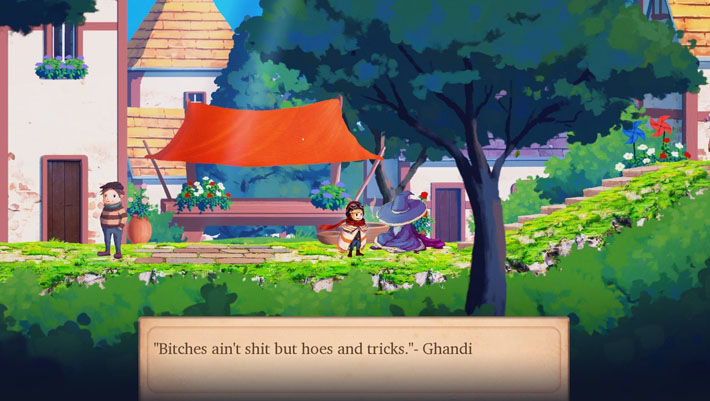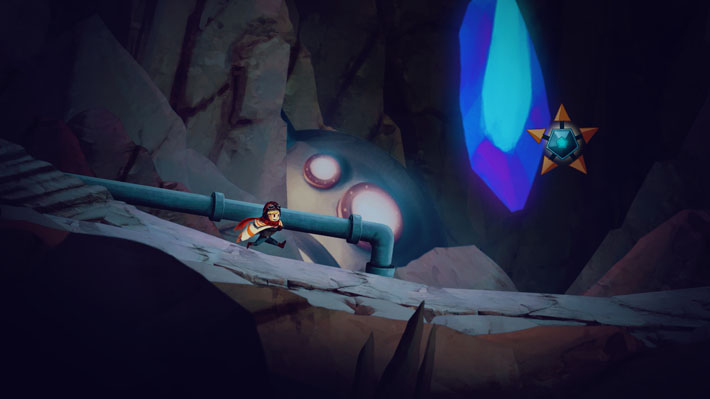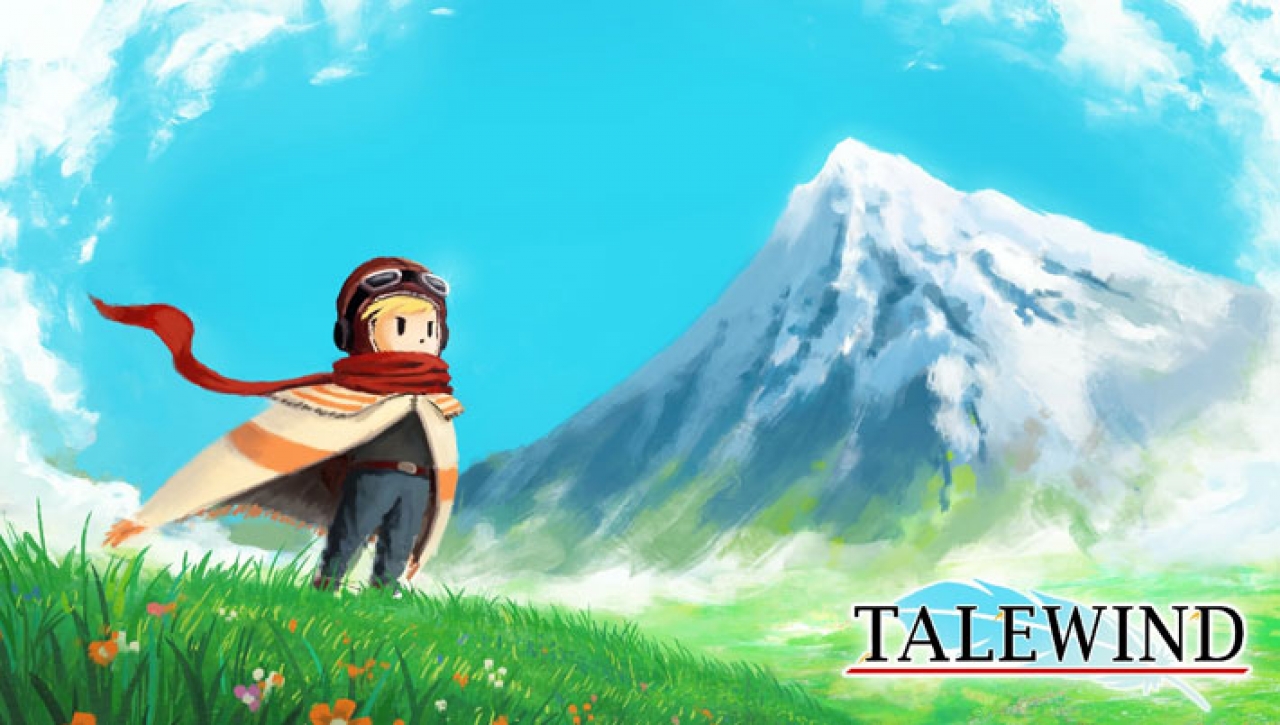Talewind is an action platformer from developer and publisher WindLimit described as “a whimsical platformer where you play as a young boy that is trying to save his village.” The title sequence goes into just a little more detail, clarifying that your village is in a mountain that is sustained by the wind; This wind stops, and your character takes it upon himself to find out what happened. Aside from this, not much is explained, which is fine for most platformers, including this one.
After the intro, you’re dropped off into a start area to learn the basic controls before you move into the town, your central hub for all later levels and bonus content. The town has a few NPCs that help give more context to your surroundings, as well as an old man who gives such insightful comments as “Procrastination is the art of keeping up with yesterday,” “No man has a good enough memory to be a successful liar,” and:

Visually, I feel our own Heather Johnson said it (wrote it?) perfectly in her Early Access Review:
“The town’s hand-painted backgrounds are whimsical, lively, and bucolic. I just want to be absorbed into the idyllic fields and tranquil blue skies that seem to extend into eternity. Talewind’s greatest strength is in the visuals, and they are seriously a sight to behold.” Outside of Early Access and now as a full release, the visuals are just as captivating as before. There’s a lighthearted, childlike look and feel to many of the animations and character design within Talewind, but it’s charmingly deceptive and a sharp contrast when compared to the difficulty of the title itself.
Gameplay is a straightforward affair with few buttons to memorize: movement, jumping/gliding, and attack, which shoots out a gust of wind that can hit one enemy at a time. There’s also a pause, level reset, and a show/hide HUD button. I found playing with a gamepad to be easier and more comfortable than a keyboard, but that may be my childhood console beginnings showing. Controls feel tight and responsive, as I was easily able to direct my character as I needed, an extremely important factor in any game, especially in a platformer where any damage is death. Your character moves at a brisk pace that isn’t too fast, but may sometimes feel slow in larger areas. Gliding is much slower that falling, helping to provide extra precision with delicate jumps and distance with larger gaps.
Levels exist in sets of 3s of two standard platforming sections followed by a level boss.
Each platforming stage has 3 bonus win conditions: a time challenge, a feather count collection, and a hidden crystal found within the stage. Time challenges are particularly trying, as they require the most streamlined path to the exit in order to pass. Many of my final times were within a few tenths of a second from the cut off, leaving very little breathing room for mistakes. Feather counts require x amount of feathers (similar to coins or rings in other games) to be gathered during the playthrough in one run. If you die and respawn at a checkpoint, all of your feathers are lost, forcing you to recollect what you need before the end. Hidden crystals are the most forgiving of the three challenges, as there is nothing preventing you from exploring your surrounds and death won’t take away your discovery. Boss sections are entertaining and a refreshing break from standard levels. Typically you’ll wait for the opportune time to attack and spend the rest of the time dodging the boss, minions, or other dangers. I’ve found that, in most cases, the quicker you attack the more hits you can deliver, and the more alive you’ll be at the end of the fight.
Accompanying each stage is themed music, which changes per level set. The majority of the BGM is fairly standard; repetitive beats with a melody that I found tiring after a while. There aren’t very many variations within the tracks to keep them fresh or dynamic, which is a shame because I enjoy most of the music present... until I’ve repeated a stage several times trying to speedrun it and grab my final crystal. Sound effects within Talewind are another interesting matter. Character movement, such as walking or jumping, is rather muted and difficult to hear over the music. Attacking enemies and being pushed through the air via wind gusts is all performed at an acceptable volume, not too soft and not too loud. Finally, turning pages from found books is surprisingly loud. Also, I’m not sure if it’s an audio glitch or not, but when I turn the pages, the sound is played three or four times in rapid succession, not unlike a machine gun that only turns pages. This audio glitch coupled with the loud sound has convinced me to avoid books at all costs in game, a difficult thing to do in the free update of Isaac’s basement (one of many upcoming free additions, according to the steam page!). These sound issues are in no way, shape or form game breaking, but they are present as of the time of this writing.
As a side note, because Tailwind is challenging and unforgiving for those looking to be a completionist, a recent criticism from players was made regarding lives and checkpoints. The past system involved a limited amount of lives given that, when depleted, required you to restart the level set. This can be frustrating due to one hit mechanics making any slip up potentially run ending. Now the player is given unlimited lives, so the difficulty remains, but the risk of resetting progress is no more. The fact that the developers listened to the community and released a patch based on feedback is very encouraging. It shows that the developers are very much invested in their title and are not content with leaving it behind as they pursue new projects.
Playing Tailwind, I found it to be a mix between casual, challenging, and frustrating.

One hit deaths can be extremely annoying when attempting to complete any of the level challenges, but ignoring them allows you to focus on purely clearing the level and advancing. Bosses with enemy spam were extremely annoying, as they forced you to speed through them before they had a chance to overwhelm you. Hit detection was… hit and miss. Some enemies I could glide through, while others would kill me as soon as I jumped over them. Levels with branching paths were exciting, but it also made some of them drag on a bit, especially when repeating the same section over and over until you clear it. Music, as mentioned, grew repetitive fairly quickly, but that is always easily remedied by listening to something else. Overall, despite the problems, I enjoyed Talewind. I think the best way to summarize my reasons for liking it would be like this:
Talewind is an ode to classic platformers with a challenging difficulty, straightforward controls, and diverse level routes, all packaged in a beautiful art style. Focusing on gameplay, Talewind ensures accessibility for casual players while easily providing a skill test for those seeking such. Minor problems aren’t as much of an issue thanks to the active attention of the developers and their eagerness to continually provide a better working experience. Regular updates and free content help this title to stay fresh and exciting without changing the formula unnecessarily, further increasing the value of the meager 10 dollar price tag.


